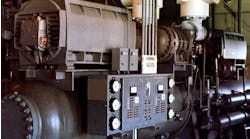Two expectations informed end-users have of electric motor service centers are reliable best practice repairs and root cause failure analysis (RCFA) to prevent recurring failures. Service centers strive to meet these expectations by performing repairs that conform with ANSI/EASA Std. AR100: Recommended Practice for the Repair of Rotating Electrical Apparatus. These service centers can also provide RCFA using a proven methodology such as that in EASA’s Root Cause Failure Analysis Seminar, which incorporates cause analysis and 5-why methods. This article focuses on the importance of performing RCFA when an electric motor fails.
The big picture
For end-users, determining the root cause of a failure is the first step toward improving the efficiency and reliability of a motor-drive system. Was there a maintenance issue or a previous failure? Was the motor well suited for the application load, torque, start-stop, and environmental requirements? Was it installed and aligned properly? Did the process change after installation?
Some maintenance professionals have the experience to analyze motor failures, but usually, it’s a task for a qualified service center. A qualified service center can also help determine what to do next, weighing such factors as the type of repair/rewind needed, the cost and availability of new equipment, the application requirements, and the efficiency/reliability of the repaired motor versus those of a new one.
Once identified, many causes of failure are easily remedied. For example, studies show motor failures commonly involve the bearings, for which replacement can be a simple, cost-effective repair. Other solutions may include improved maintenance, condition monitoring, a motor rewind, or a replacement motor. However, unless the root cause of failure is determined, neither efficiency nor reliability will improve — even with a new motor.
Applying RCFA
To appreciate the value of RCFA, consider what might happen without it. A good example is the case history of a failed 200-hp (150kW) air compressor motor with a thoroughly overheated winding (Photo on the right). Since the motor’s service factor (SF) was within the operating range of many compressors — and with no other evidence available — the service center logically concluded the cause of failure was an overload/overcurrent condition. After conferring with the end-user, the service center rewound the motor, upgrading its insulation system from class B (130°C) to class H (180°C) to prevent a recurrence.
Unfortunately, the initial failure analysis in this case was cursory. The service center jumped to the conclusion that an overload/overcurrent condition fried the winding without asking what else could have caused it.
Applying the RCFA methodology would have examined the motor’s failure mode, pattern, and appearance as well as its application and maintenance history. RCFA also would have considered the entire motor-drive system, not just the motor. System elements include the motor’s power supply, foundation, method of connection to driven equipment, and the driven equipment (Fig. 1).
Before continuing with this case history, let’s take a deeper dive into using cause analysis and the 5-why methods for RCFA.
Cause analysis and 5-why methods
RCFA is the focus here, but it draws lessons from the cause analysis (CA) and 5-why methods. Compared with RCFA, CA is a more generic way to identify the potential root cause(s) of any problem and prevent or at least minimize its recurrence. The 5-why methodology offers a simple yet effective way to use CA. Despite its name, the intent of 5-why is not to ask “why” five times but to emphasize the need to drill down through several levels when investigating some problems. Sometimes, two levels are enough; other times, it may take more than five.
Figure 2 on page 16 shows a 5-why flowchart, the first step of which is called problem characteristics. For RCFA, this typically means gathering enough data in each of five categories to analyze the cause(s) of a problem or failure:
- Failure mode: Manifestation, form, or arrangement of the failure (e.g., stator winding turn-to-turn, phase-to-phase).
- Failure pattern: Configuration of the failure (e.g., symmetrical or nonsymmetrical).
- Appearance: Damage, contamination, moisture, cracks, or other signs of stress in the failed part, other motor parts, and the motor-drive system.
- Application: The work the motor performs and its load characteristics.
- Maintenance history: The work that has been done to keep the motor and system operating properly.
Ideally, a service center will have all relevant information about the system’s application, appearance, and maintenance history before it inspects a motor or failed component. But the urgency to return the motor to service often dictates that inspection comes first. Application and historical data may only be available later, if ever.
Testing and verification of potential causes of failure should be as thorough as practical, comparing the failed motor with identical motors in the same application, if possible. For example, voltage unbalance is easy to test on-site, but a suspected transient voltage event should not be duplicated intentionally to verify that it damages windings.
Applying RCFA
Given that background, how did RCFA change the case history of our failed compressor motor? First, recall the information initially available — a motor with an SF rating suitable for its application with thermal degradation in all phases of its winding. Based on this, the service center attributed the cause of failure to an overload/overcurrent condition and rewound the motor with an upgraded class H insulation system to prevent recurrence. When the motor continued to fail after multiple rewinds, including a redesign to a higher rating, the service center turned to RCFA.
As part of the RCFA process, the service center methodically examined the motor and system trying to narrow down possible causes of failure. Following the 5-why approach, they kept asking “why” until they ruled out or identified a probable root cause of failure. For example, when they measured the subject motor’s actual operating current with load and recorded it on the RCFA template shown in Fig. 3, they found it did not exceed the nameplate rating. That led them to look for other reasons “why” the motor’s operating temperature kept getting hot enough to damage the winding, including the possibility of reduced airflow or a restricted ventilation system.
As a result of the RCFA and 5-why process, they discovered that the cooling fan in the compressor enclosure was rotating in the wrong direction. Due to reduced airflow, the ambient temperature was more than 40°F (22°C) above normal, which would be recorded in the blank template shown in
Fig. 4.
As this case history of a compressor motor shows, the initial misdiagnosis of overload as the cause of failure resulted in multiple unnecessary rewind-failure cycles. Once RCFA correctly identified the direction of cooling fan rotation as the root cause of failure, the problem was corrected. That same compressor motor has been operating successfully now for more than a decade.
Conclusion
The lesson learned for the end-user and the service center that repaired the compressor motor is that there are times when RCFA should be used, even if it may appear to be costly and time-consuming.








